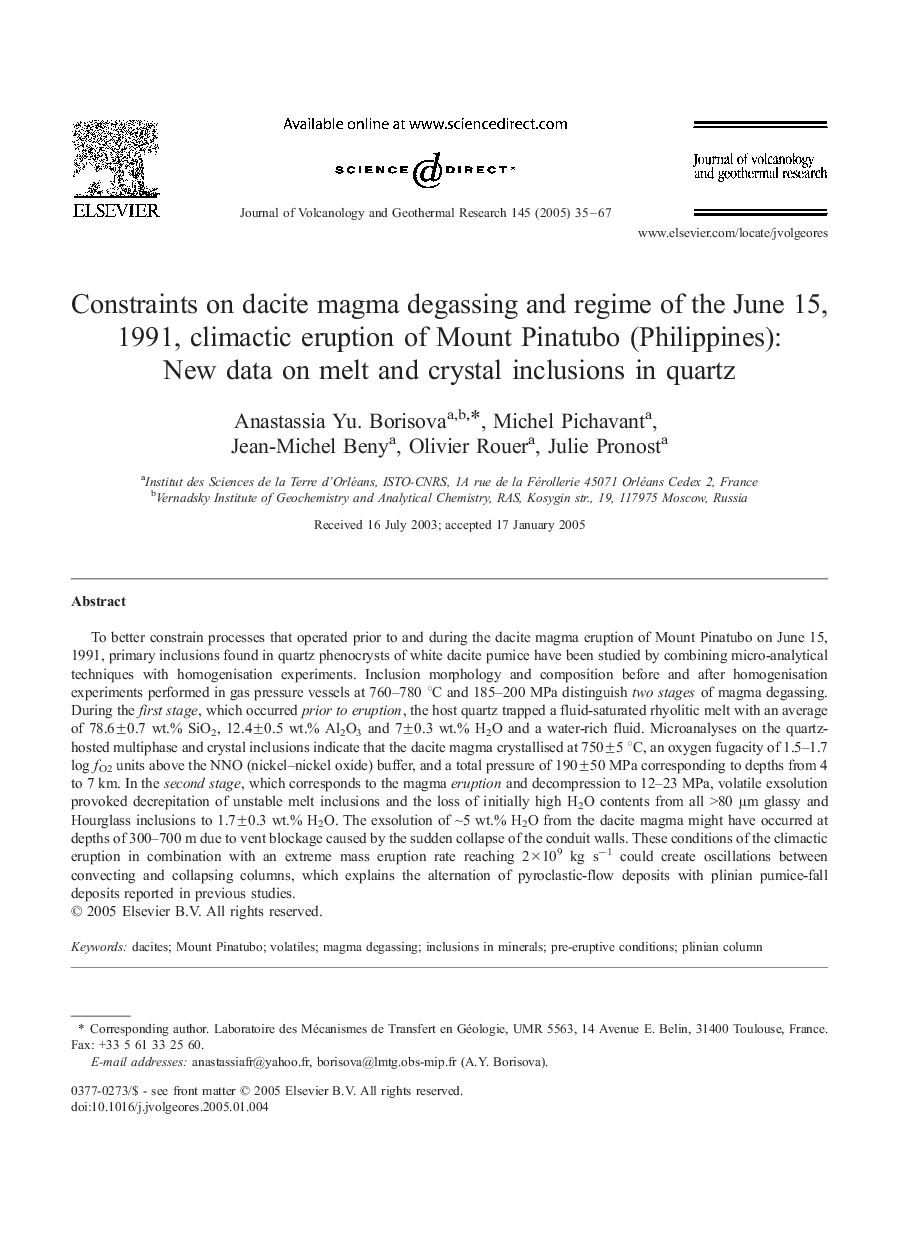| کد مقاله | کد نشریه | سال انتشار | مقاله انگلیسی | نسخه تمام متن |
|---|---|---|---|---|
| 9531091 | 1638494 | 2005 | 33 صفحه PDF | دانلود رایگان |
عنوان انگلیسی مقاله ISI
Constraints on dacite magma degassing and regime of the June 15, 1991, climactic eruption of Mount Pinatubo (Philippines): New data on melt and crystal inclusions in quartz
دانلود مقاله + سفارش ترجمه
دانلود مقاله ISI انگلیسی
رایگان برای ایرانیان
کلمات کلیدی
موضوعات مرتبط
مهندسی و علوم پایه
علوم زمین و سیارات
ژئوشیمی و پترولوژی
پیش نمایش صفحه اول مقاله

چکیده انگلیسی
To better constrain processes that operated prior to and during the dacite magma eruption of Mount Pinatubo on June 15, 1991, primary inclusions found in quartz phenocrysts of white dacite pumice have been studied by combining micro-analytical techniques with homogenisation experiments. Inclusion morphology and composition before and after homogenisation experiments performed in gas pressure vessels at 760-780 °C and 185-200 MPa distinguish two stages of magma degassing. During the first stage, which occurred prior to eruption, the host quartz trapped a fluid-saturated rhyolitic melt with an average of 78.6±0.7 wt.% SiO2, 12.4±0.5 wt.% Al2O3 and 7±0.3 wt.% H2O and a water-rich fluid. Microanalyses on the quartz-hosted multiphase and crystal inclusions indicate that the dacite magma crystallised at 750±5 °C, an oxygen fugacity of 1.5-1.7 log fO2 units above the NNO (nickel-nickel oxide) buffer, and a total pressure of 190±50 MPa corresponding to depths from 4 to 7 km. In the second stage, which corresponds to the magma eruption and decompression to 12-23 MPa, volatile exsolution provoked decrepitation of unstable melt inclusions and the loss of initially high H2O contents from all >80 μm glassy and Hourglass inclusions to 1.7±0.3 wt.% H2O. The exsolution of â¼5 wt.% H2O from the dacite magma might have occurred at depths of 300-700 m due to vent blockage caused by the sudden collapse of the conduit walls. These conditions of the climactic eruption in combination with an extreme mass eruption rate reaching 2Ã109 kg sâ1 could create oscillations between convecting and collapsing columns, which explains the alternation of pyroclastic-flow deposits with plinian pumice-fall deposits reported in previous studies.
ناشر
Database: Elsevier - ScienceDirect (ساینس دایرکت)
Journal: Journal of Volcanology and Geothermal Research - Volume 145, Issues 1â2, 15 July 2005, Pages 35-67
Journal: Journal of Volcanology and Geothermal Research - Volume 145, Issues 1â2, 15 July 2005, Pages 35-67
نویسندگان
Anastassia Yu. Borisova, Michel Pichavant, Jean-Michel Beny, Olivier Rouer, Julie Pronost,